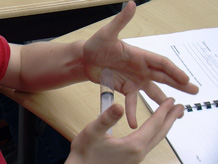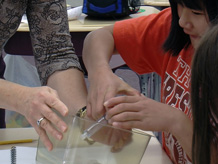What are some properties of air? (1)
2. Explore compressibility
Predict
Have students predict and explain their reasoning in their Science Notebooks, [Predicting the compressibility of water and air].
Air in a single syringe

Distribute a 12cc syringe to each student. Direct students to:
- Pull the plunger back to the 12cc mark.
- Cover the small opening in the syringe barrel with the palm of one hand.
- Push the plunger.
- Consider these questions:
- Does the plunger move?
- What happens when you release the plunger?
Students only need a minute or two to explore the compressibility of air with the syringes. Collect the syringes when they are finished.
Note: As students explore the compressibility of air, they may become interested in whether or not the syringe plunger returns to the exact same spot once it has been released. It may not, due to friction between the rubber seal and the plastic barrel of the syringe, or because a tiny bit of air leaked out between the syringe and the palm of the hand. Neither of these possibilities should distract from the big idea that air can be squeezed into a smaller space, and will expand again once the plunger of the syringe is released.
Water and air in a syringe
How does the compressibility of water compare with the compressibility of air?

Move from group to group with two plastic buckets each holding two capped water-filled syringes and two capped air-filled syringes. Under your supervision, give four students at a time an opportunity to compress water and air in syringes. Be sure students point the capped ends of their syringes into one of the plastic buckets before they apply pressure to the plungers. In the unlikely event that the pressure causes a cap to release, the water and cap will end up in the plastic bucket.
Provide a few minutes for students to record observations on the [Observing the compressibility of water and air] page in their Science Notebooks.
Note: Liquids and solids are compressible, but only to a tiny degree in comparison with air or gases in general.
Is there another property of air we can now add to the list?
- Air can be squeezed into a smaller space; it is compressible.
Does this compressibility change our finding that air takes up space?
- No. Air still takes up space, but the amount of space it takes up can change when it is squeezed or compressed in a closed system. (Sealing the opening of the syringe changes it temporarily into a small closed system.) Air can't be squeezed so much that it takes up no room at all.
Letter from the Engineer
When you compressed air in the syringe, maybe you noticed that it pushed back with a little bounce. Air acts somewhat like a spring. You can compress it, or squeeze it into a smaller volume. When you push on the plunger you can feel the air pushing back. When you stop pushing, the air inside the syringe will return to its original size.
There are different ways to compress air. One way is to squeeze a certain volume of air into a smaller space. That’s what you did with the syringe. Another way is to use a pump, like a bicycle pump, to squeeze extra air into something that is already full of air. That’s what you do when you pump air into a basketball, soccer ball, or bicycle tire. Why is it possible to add more air to something that is already full of air? Only because air is easily compressible — the particles can be squeezed closer together. (Remember how different it felt when you tried to compress water in the syringe?)
The bouncy feeling you notice when you compress air can be very useful. When you dribble a basketball, the part of the ball that hits the floor gets pressed into the ball a little bit. It’s a little like pushing the handle of the syringe or squeezing a spring. The air inside the ball gets squeezed, and it springs back, just like the handle of the syringe did. This “springing back” makes the ball bounces back up to you. Maybe you have tried to dribble a basketball or kick a soccer ball that did not have much air in it. If you have, you know the ball does not have the same kind of springiness or bounce.



